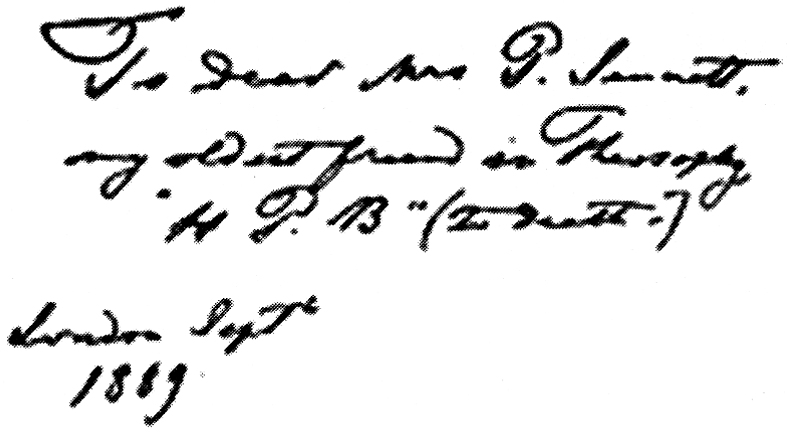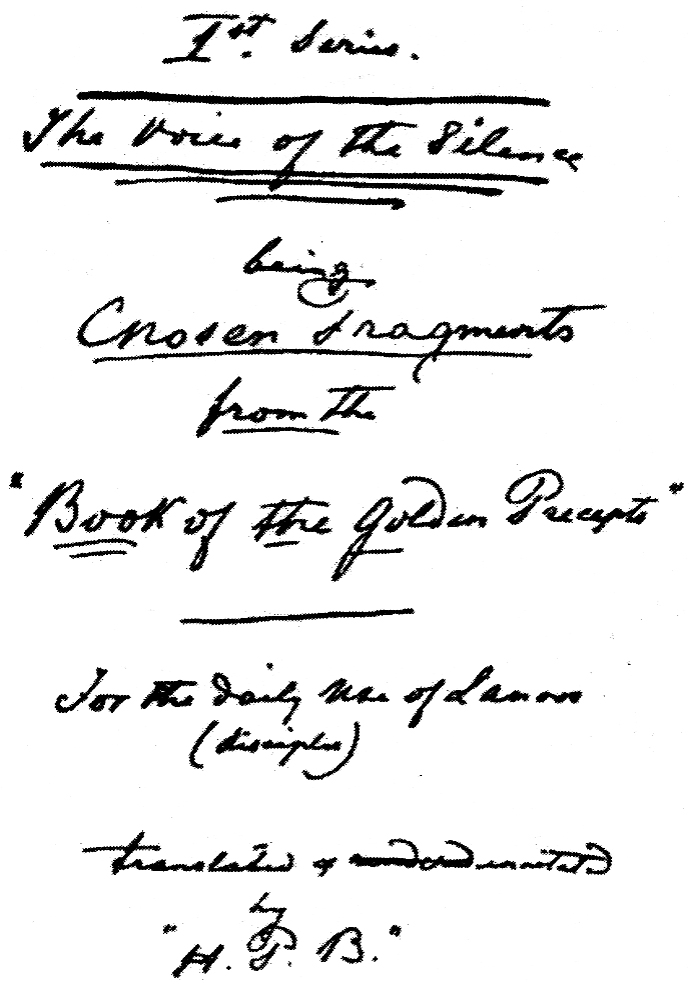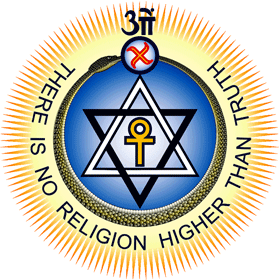April 2014 Newsletter
The following articles are reproduced from the April 2014 Newsletter to members. Non-members may or may not be able to relate to the contents.
The Voice of the Silence
‘HPB’s Most Precious Book’
By C. A. Shinde
Reprinted from The Theosophist Feb. 2014
It has been 125 years since The Voice of the Silence was first published in the year 1889 and H. P. Blavatsky passed away in 1891. It was her last literary gift to the world for the moral and spiritual upliftment of humanity. It is a small book, what may be called a prose poem full of spiritual inspiration divided into three fragments. HPB wrote it without referring to any books continuously hour after hour and it is not a hotchpotch drawn from various sources through her special spiritual power, but it is a coherent ethical whole appealing to human spiritual nature. There are two autograph copies of the American edition at Adyar. One in the Archives, the other in the library as presentation copies by HPB to H. P. Blavatsky and HPB to Mrs P. Sinnett respectively. She wrote HPB to H. P. Blavatsky, one is with initials and the other is with full name. About initials she herself has described in her book on the title page as translated and annotated by HPB. HPB is her inner being and H. P. Blavatsky is her outer form. Autograph in HPB’s own copy of The Voice of the Silence expressing the regret of one who is conscious how the spoken word falls short of the silent voice (on page 87, 88).

“H.P.B. to H.P. Blavatsky with no kind regards.”
Autograph in HPB's own copy of The Voice of the Silence, expressing the regret of one who is conscious of how the spoken word falls short of the Silent Voice.

“To dear Mrs P. Sinnett,
my oldest friend in Theosophy,
“H.P.B” (to death.)
London Sept
1889”
Autograph in Mrs Sinnett’s copy (reduced)
This is a book of Esoteric Buddhism which explains the teachings of the Buddha. She gave many outstanding books to the world such as Isis Unveiled, The Secret Doctrine and The Key to Theosophy and in this her last gift, the whole philosophy of her life is summed up and therefore described as ‘the greatest thing’ in modern Theosophical literature. We all are ever grateful to her for the great truth of life she has revealed. There is great similarity in the teachings contained in The Voice of the Silence and the teachings of Vedanta.
HPB says about origin of the book that she derived information from The Book of the Golden Precepts, written for mystic students. The maxims and ideas contained in it are found under different forms particularly in Upanishad and Gita. There would be little reason to wonder how she referred The Gnyāneshwari which is not a Sanskrit work, but was written in Marathi in the thirteenth century of our era. There is also reference to the Yogācharya school of the Mahayana. It is also said, the origin of the book has its connection with The Book of Dzyan, with the Buddhist sage Aryasanga, and the Master Djwal Kul which one can read in C. W. Leadbeater's book Talks on the Path of Occultism volume II.
We cannot disregard HPB’s own statement contained in a letter written to her sister, Vera P. de Zhelihovsky, written in February 1890:
“They are grand aphorisms, indeed. I may say so, because you know I did not invent them! I only translated them from Telegu, the oldest South Indian dialect. There are three treatises about morals, and the moral principles of the Mongolian and Dravidian mystics. Some of the aphorisms are Wonderfully deep and beautiful.”
Dr Annie Besant’s testimony for HPB's writing of The Voice of the Silence is important to consider.
She wrote it at Fontainebleau, and the great part was done when I was with her, and I sat in the room while she was writing it. I know that she did not write it referring to any books, but she wrote it down steadily hour after hour, exactly as though she were writing either from memory or from reading it where no book was. She produced in the evening that manuscript that I saw her write as I sat with her, and asked me and others to correct it for English, for she said that she had written it so quickly that it was sure to be bad, we did not alter in that more than a few words, and it remains as a specimen for marvellously beautiful literary work.

Autograph of the title page (reduced)
Each fragment of the book consists of about one hundred verses. The first two fragments are of a preparatory nature, leading up to the third and the third fragment deals with seven paramitas or perfections. The first fragment is mainly concerned with making the distracted mind the calm mind by passing through the three halls. From the hall of ignorance, through hall of learning to the hall of wisdom. Aspirant prepares himself to discover his own path. Each one has his own temperament and therefore there is a path to each temperament which is to be discovered by oneself. Then the second fragment deals with the two Paths. One is the Path of liberation from limitation and the other is the Path of woe or renunciation that involves path of living to benefit the mankind. Without such right vision treading the path becomes impossible and therefore he should find seven golden keys to seven portals or six paramitas or perfections. If one asks what is the underlying philosophy of The Voice of the Silence, the answer given by HPB in one sentence is ‘The mind is the great Slayer of the Real, Let the Disciple Slay the Slayer.'
Slayer of the Real
Slaying of mind means the transcending of the mind and HPB shows in these three fragments how the human mind can be transcended with the help of mind. This transcending involves Self discovery. Mind must first explore and discover its own limitations and possibilities.
In reality the basic quality of mind is desire (kāma). Slay the slayer indicates to the rising of the mind principle (manas) or consciousness. The Kāma manas or desire mind is the great Slayer of the Real, as it has passions for the non-spiritual world. It takes immense delight in having wealth, fame and position of power. It feels pleased if one follows it, otherwise it feels unhappy. It is said only strong can manage or master this mind with his spiritual discriminative quality. Tamasic or dull mind, Rajasic or over active mind, cannot do this. Spiritual discrimination is the attribute of that mind through which Light of Buddhi shines. Violent feelings, hot arguments are the indication of absence of such Light therefore it simply complains and never takes the responsibility. Such a mind becomes self-centred and therefore its perception is not real. It loses its simplicity and innocence. Simple and innocent mind cannot be the Slayer of the Real immediately, rather it becomes a learning mind. It watchfully introspects the division between outer tempting feelings and inner feelings of experiences, memories, and reactions, to create the feeling of ‘me’ that one needs to realize that it is impermanent. HPB asks the disciple to slay this impermanent aggregation of memories and experiences. There is an important verse which needs to be contemplated by the aspirant who is really hungry for the acquirement of soul wisdom.
‘For mind is like a mirror, it gathers dust while it reflects’. It needs the gentle breeze of soul-wisdom to brush away the dust of our illusions. ‘Seek O Beginner, to blend thy Mind and Soul’. For such blending of mind with the soul, the mind should be free from cultured things to receive spiritual insights. HPB makes it clear that the dust on the mirror of mind involves prejudices, illusions, and fancies. Gentle breeze of soul wisdom in one sense is to intellectualize and realize the fact that in the welfare of all, one’s own welfare is also involved because there is no separate welfare as such. Krishnaji once said there is no personal Will — there is only Divine Will. The personal Will implies a strong drive for fame, name, money, power etc. which needs to be brushed away by the gentle breeze of soul wisdom for transcending the kāma manas i.e. mind must become free from domination of desire and dust of illusions. This is to surrender personal will to the divine Will through the power of creativeness within. HPB writes in Isis Unveiled: The great Universal Idea willed and the cosmos sprang into existence.
Unless there is emptiness Silence of in the mind, the creative energy of Love may not emanate from the Being within. Emptiness involves not only turning the mind away from the social, the economical, the political, the science and technology but also to turn away from the thought structure, from the philosophy, the scriptures, and from all that one knows and also from wanting to know, the inquiry world around oneself. Little drops of water make a mighty ocean. So little acts of compassion through transcended new mind make the world happy and peaceful as every one of us is part of that one energy field of Universal Consciousness and Alaya. The eight cognitions and five Wisdoms of the yoga chara school, may help us to understand The Voice of the Silence. The views of the mind and consciousness are still held by all Buddhist Schools.

To transcend the mind or to slay the slayer right efforts are necessary to brush aside all the useless things in one’s mind. One way of cleaning up our mind is to fill the mind with sublime ideas and holy thoughts. If one develops this habit then unconscious mind becomes a golden mine instead of rubbish heap. Thus wise and strong one is able to gain mastery over the conscious and unconscious mind and rise to the super conscious state, the purest state of mind and thus be able to slay the slayer in true sense. The Voice of the Silence also says ‘Slay the Lunar form at Will’. At Will means individually each must investigate deeply the hidden laws of nature and arrange one’s daily life according to those natural laws using one’s faculty of reasoning and common sense. It is the duty of every man who is capable of an unselfish impulse, to do something, however little for its (humanity’s) welfare (ML. 32).
Prof. C. A. Shinde is a National Lecturer of the Indian Section of the TS, and Librarian of the Adyar Library. The year 2014 marks the 125th anniversary of The Voice of the Silence.
The Voice of The Silence is the subject of our Study Class for 2014, the 125th Anniversary of the publication of the Book.
Look out for the commencement of the Study Class!
